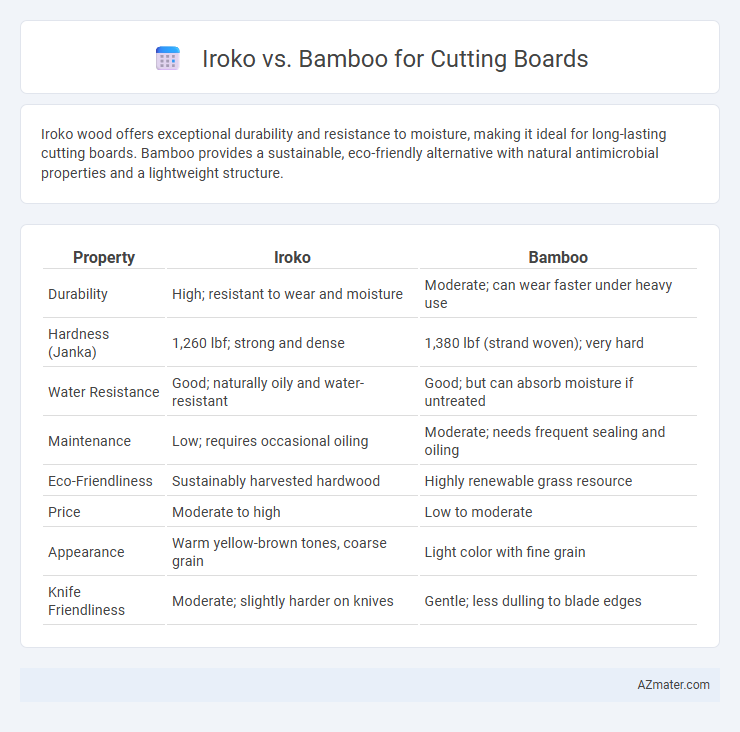Iroko wood offers exceptional durability and resistance to moisture, making it ideal for long-lasting cutting boards. Bamboo provides a sustainable, eco-friendly alternative with natural antimicrobial properties and a lightweight structure.
Table of Comparison
| Property | Iroko | Bamboo |
|---|---|---|
| Durability | High; resistant to wear and moisture | Moderate; can wear faster under heavy use |
| Hardness (Janka) | 1,260 lbf; strong and dense | 1,380 lbf (strand woven); very hard |
| Water Resistance | Good; naturally oily and water-resistant | Good; but can absorb moisture if untreated |
| Maintenance | Low; requires occasional oiling | Moderate; needs frequent sealing and oiling |
| Eco-Friendliness | Sustainably harvested hardwood | Highly renewable grass resource |
| Price | Moderate to high | Low to moderate |
| Appearance | Warm yellow-brown tones, coarse grain | Light color with fine grain |
| Knife Friendliness | Moderate; slightly harder on knives | Gentle; less dulling to blade edges |
Introduction: Choosing the Right Cutting Board Material
Iroko and bamboo represent two popular cutting board materials, each with distinct qualities that affect performance and durability. Iroko, a dense hardwood native to Africa, offers exceptional resistance to knife marks and moisture, making it ideal for heavy-duty kitchen use. Bamboo, a fast-growing grass, provides an eco-friendly, lightweight option with natural antimicrobial properties and sufficient hardness for everyday chopping tasks.
Iroko Wood: Characteristics and Benefits
Iroko wood, known as the African teak, features high density and natural resistance to moisture and bacteria, making it an ideal choice for cutting boards. Its coarse grain structure provides durability and excellent knife edge retention, reducing wear over time. Unlike bamboo, Iroko offers superior hardness and longevity while maintaining a rich golden to dark brown hue that enhances kitchen aesthetics.
Bamboo: Features and Advantages
Bamboo cutting boards offer exceptional durability and resistance to knife scars due to the plant's dense fiber structure, which helps maintain a smooth surface over time. Bamboo is naturally antimicrobial, reducing the risk of bacterial growth and making it a hygienic choice for food preparation. Furthermore, bamboo is an eco-friendly option because it regenerates rapidly, ensuring sustainable harvesting without contributing to deforestation.
Durability Comparison: Iroko vs Bamboo
Iroko wood offers exceptional durability for cutting boards due to its dense, oily grain that resists moisture, scratches, and bacteria, making it ideal for heavy kitchen use. Bamboo, while eco-friendly and harder than many hardwoods, is more prone to surface cracking and may require more frequent maintenance to prevent wear and tear. Overall, Iroko provides superior longevity and resilience compared to bamboo, especially in high-moisture or rigorous cutting environments.
Knife Friendliness: Impact on Blades
Iroko wood offers excellent knife friendliness for cutting boards due to its moderate hardness, providing a balance between durability and blade preservation. Bamboo, while harder and more durable, can be tougher on knife edges, often causing quicker dulling because of its dense fiber structure. Choosing Iroko enhances blade longevity by minimizing wear, making it a preferred material for those seeking a cutting board that protects knives.
Maintenance and Care Requirements
Iroko cutting boards require regular oiling with food-safe mineral oil to prevent drying and cracking, while bamboo boards benefit from similar oiling but may need more frequent applications due to their denser fibers. Both materials should be cleaned with mild soap and water, avoiding soaking to maintain their integrity and extend lifespan. Bamboo is naturally more resistant to moisture and bacteria, reducing the risk of warping compared to iroko, which demands careful drying after each wash to prevent damage.
Hygiene and Food Safety Factors
Iroko wood is naturally antimicrobial and resistant to bacteria, making it a hygienic choice for cutting boards that minimizes food contamination risks. Bamboo is also known for its antibacterial properties and is less porous than many woods, which reduces moisture absorption and inhibits bacterial growth on the cutting surface. Both materials offer food-safe options, but Iroko's dense grain structure provides enhanced durability and resistance to knife marks where bacteria can harbor.
Environmental Sustainability: Iroko vs Bamboo
Iroko wood, a hardwood sourced from West Africa, is durable and long-lasting but often involves slower growth rates and less renewable harvesting practices compared to bamboo. Bamboo is a rapidly renewable grass that regenerates quickly without needing replanting, making it a highly sustainable option for cutting boards. Selecting bamboo cutting boards supports lower environmental impact through faster replenishment and reduced deforestation risks compared to iroko.
Price and Availability Comparison
Iroko cutting boards typically range from $50 to $100 depending on size and quality, offering good durability at a moderate price point. Bamboo boards are generally more affordable, often priced between $20 and $60, with widespread availability in most kitchenware stores and online retailers. Both materials are readily accessible, but bamboo's faster growth rate contributes to its lower cost and broader market presence compared to the denser, less common Iroko wood.
Final Verdict: Which is Better for Cutting Boards?
Iroko offers exceptional durability and natural resistance to bacteria, making it highly suitable for heavy use in cutting boards, while bamboo provides a sustainable and lightweight option with moderate hardness and quicker healing of knife marks. Bamboo's eco-friendliness and affordability appeal to environmentally conscious consumers, but Iroko's close grain structure minimizes moisture absorption, enhancing longevity and hygiene. For cutting boards requiring long-term resilience and minimal maintenance, Iroko emerges as the superior choice overall.

Infographic: Iroko vs Bamboo for Cutting Board
 azmater.com
azmater.com